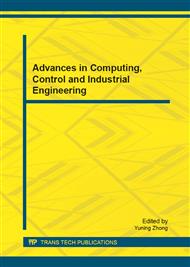p.90
p.96
p.101
p.107
p.111
p.119
p.124
p.129
p.135
A Threat Sorting Approach Based on the Fuzzy Beliefs
Abstract:
To overcome the limitations of the traditional threat assessment algorithms, a new threat sorting approach based on the fuzzy belief is proposed in this paper. In the new approach, the threat degrees described by quantitative number, interval number or linguistic label are all converted into the triangular fuzzy beliefs. The proportional conflict redistribution rule is used to combine the threat degrees of the same kind of assessment factors, the decision discounting rule is used to combine the threat degrees of different kinds of assessment factors, and the centroid method is utilized to make threat sorting. The new approach can not only deal with uncertain threat degrees, but also fuse the quantitative and qualitative threat degrees. The performance of the approach is analyzed in theory in this paper and the experimental results have certified its validity too.
Info:
Periodical:
Pages:
111-116
Citation:
Online since:
November 2012
Authors:
Keywords:
Price:
Сopyright:
© 2012 Trans Tech Publications Ltd. All Rights Reserved
Share:
Citation:


